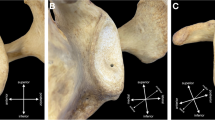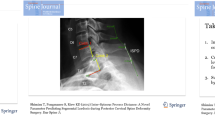Abstract
Purpose
To measure the morphological dimensions of the spinous process (SP) and interspinous space, and provide a basis for the development of interspinous devices for the Korean or East Asian populations.
Methods
We retrospectively analyzed the anatomical parameters of 120 patients. The parameters included height, length, and width of SP, interspinous distance (supine, standing, and dynamic), cortical thickness of SP, and spino-laminar (S-L) angle. Correlations between measurements, age, and gender were investigated.
Results
The largest height, length, and cortical thickness and S-L angle were noted at L3. The largest width was observed at S1. The interspinous distance decreased significantly from L2–3 to L5–S1 and was significantly larger in the supine than in standing posture for L5–S1. Cortical thickness was gradually tapered from the anterior to the posterior position. The S-L angle at L2 and L3 was similar and significantly decreased from L3 to S1. An increased trend in width with aging and a decreased trend in distance (supine) were noted. A significant increase in height, length, and distance in males compared with females was also observed.
Conclusions
The interspinous space is wider at the anterior, and the cortex is thicker anteriorly. Accordingly, it appears that the optimized implant position lies in the interspinous space anteriorly. The varying interspinous space with different postures and gradually narrowing with age suggest the need for caution when sizing the device. Gender differences also need to be considered when designing implantable devices.





Similar content being viewed by others
References
Albietz JS, Rosasarellano P, Fleming JC, Gurr KR, Bailey SI, Bailey CS (2012) An anatomic study of the interspinous space of the lumbosacral spine. Eur Spine J 21:145–148
Anderson PA, Tribus CB, Kitchel SH (2006) Treatment of neurogenic claudication by interspinous decompression: application of the X STOP device in patients with lumbar degenerative spondylolisthesis. J Neurosurg Spine 4:463–471
Bono CM, Vaccaro AR (2007) Interspinous process devices in the lumbar spine. J Spinal Disord Tech 20:255–261
Bowers C, Amini A, Dailey AT, Schmidt MH (2010) Dynamic interspinous process stabilization: review of complications associated with the X-Stop device. Neurosurg Focus 28:E8
Chen PG, Daubs MD, Berven S et al (2016) Surgery for degenerative lumbar scoliosis: the development of appropriateness criteria. Spine (Phila Pa) 41:910–918
Fransen P (2017) Long-term results with percutaneous interspinous process devices in the treatment of neurogenic intermittent claudication. J Spine Surg 3:620–623
Gala RJ, Russo GS, Whang PG (2017) Interspinous implants to treat spinal stenosis. Curr Rev Musculoskelet Med 10:182–188
Gazzeri R, Galarza M, Neroni M et al (2015) Failure rates and complications of interspinous process decompression devices: a European multicenter study. Neurosurg Focus 39:E14
Ihm EH, Han IB, Shin DA, Kim TG, Huh R, Chung SS (2013) Spinous process morphometry for interspinous device implantation in Korean patients. World Neurosurg 79:172–176
Kim DH, Albert TJ (2007) Interspinous process spacers. J Am Acad Orthop Surg 15:200–207
Kondrashov DG, Hannibal M, Hsu KY, Zucherman JF (2006) Interspinous process decompression with the X-STOP device for lumbar spinal stenosis: a 4-year follow-up study. J Spinal Disord Tech 19:323–327
Lee HM, Kim NH, Kim HJ, Chung IH (1995) Morphometric study of the lumbar spinal canal in the Korean population. Spine (Phila Pa) 20:1679–1684
Lurie J, Tomkins-Lane C (2016) Management of lumbar spinal stenosis. BMJ 352:h6234
Mariottini A, Pieri S, Giachi S et al (2005) Preliminary results of a soft novel lumbar intervertebral prothesis (DIAM) in the degenerative spinal pathology. Acta Neurochir Suppl 92:129–131
Miscusi M, Trungu S, Forcato S, Ramieri A, Polli FM, Raco A (2018) Long-term clinical outcomes and quality of life in elderly patients treated with interspinous devices for lumbar spinal stenosis. J Neurol Surg A Cent Eur Neurosurg 79:139–144
Ortega A, Sarmiento JM, Patil C et al (2015) Comparative analysis of inpatient and outpatient interspinous process device placement for lumbar spinal stenosis. J Neurol Surg A Cent Eur Neurosurg 76:443–450
Phan K, Rao PJ, Ball JR, Mobbs RJ (2016) Interspinous process spacers versus traditional decompression for lumbar spinal stenosis: systematic review and meta-analysis. J Spine Surg 2:31–40
Puzzilli F, Gazzeri R, Galarza M et al (2014) Interspinous spacer decompression (X-STOP) for lumbar spinal stenosis and degenerative disk disease: a multicenter study with a minimum 3-year follow-up. Clin Neurol Neurosurg 124:166–174
Ran B, Li Q, Yu B, Chen X, Guo K (2015) Morphometry of lumbar spinous process via three dimensional CT reconstruction in a Chinese population. Int J Clin Exp Med 8:1129–1136
Richards JC, Majumdar S, Lindsey DP, Beaupré GS, Yerby SA (2005) The treatment mechanism of an interspinous process implant for lumbar neurogenic intermittent claudication. Spine (Phila Pa) 30:744–749
Ross PD, Wasnich RD, Davis JW, Vogel JM (1991) Vertebral dimension differences between Caucasian populations, and between Caucasians and Japanese. Bone 12:107–112
Siewe J, Selbeck M, Koy T et al (2015) Indications and contraindications: interspinous process decompression devices in lumbar spine surgery. J Neurol Surg A Cent Eur Neurosurg 76:1–7
Sobottke R, Koy T, Röllinghoff M et al (2010) Computed tomography measurements of the lumbar spinous processes and interspinous space. Surg Radiol Anat 32:731–738
Verhoof OJ, Bron JL, Wapstra FH, van Royen BJ (2008) High failure rate of the interspinous distraction device (X-Stop) for the treatment of lumbar spinal stenosis caused by degenerative spondylolisthesis. Eur Spine J 17:188–192
Weinstein JN, Tosteson TD, Lurie JD et al (2010) Surgical versus nonoperative treatment for lumbar spinal stenosis four-year results of the spine patient outcomes research trial. Spine (Phila Pa) 35:1329–1338
Wu AM, Zhou Y, Li QL et al (2014) Interspinous spacer versus traditional decompressive surgery for lumbar spinal stenosis: a systematic review and meta-analysis. PloS One 9:e97142
Xu C, Ni WF, Tian NF, Hu XQ, Li F, Xu HZ (2013) Complications in degenerative lumbar disease treated with a dynamic interspinous spacer (Coflex). Int Orthop 37:2199–2204
Acknowledgements
This material is based upon work supported by the Ministry of Trade, Industry & Energy (MOTIE, Korea) under Industrial Technology Innovation Program. No.10062712, “Development of spinal fusion implant and its manufacturing system; the functionally optimized, patient-customized in terms of bioactive materials to meet the clinical needs”; China Scholarship Council (CSC, no. [2016]3100).
Author information
Authors and Affiliations
Corresponding author
Ethics declarations
Conflict of interest
All the authors declare that no actual or potential conflict of interest exists. All authors have contributed to the material and preparation of this manuscript.
Rights and permissions
About this article
Cite this article
Lin, GX., Suen, TK., Quillo-Olvera, J. et al. Dimensions of the spinous process and interspinous space: a morphometric study. Surg Radiol Anat 40, 1383–1390 (2018). https://doi.org/10.1007/s00276-018-2096-z
Received:
Accepted:
Published:
Issue Date:
DOI: https://doi.org/10.1007/s00276-018-2096-z




